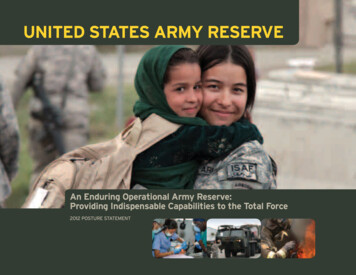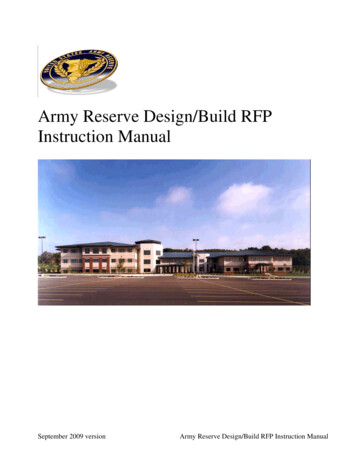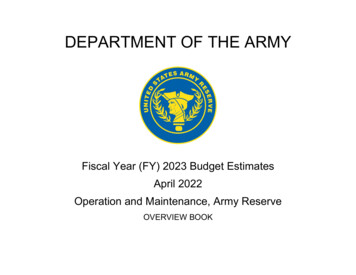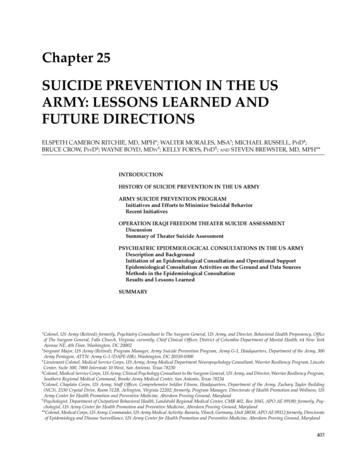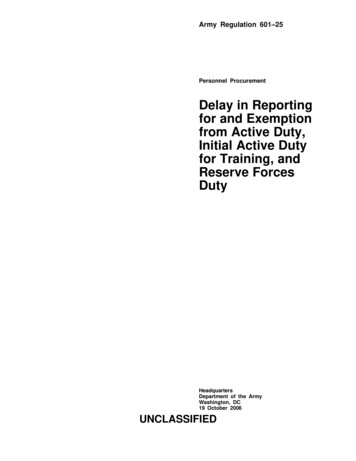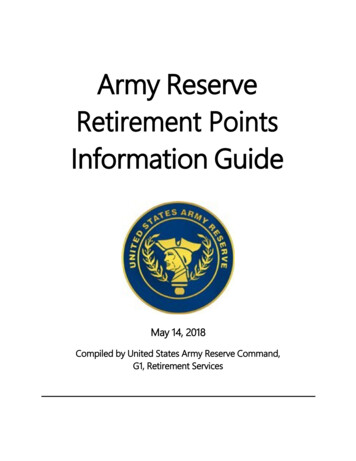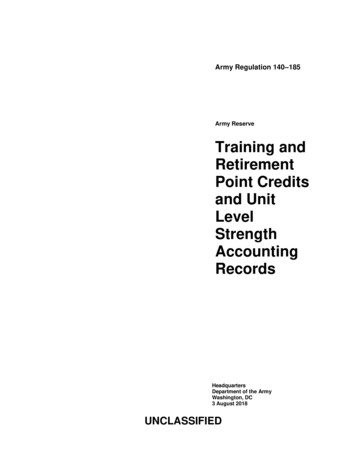
Transcription
Army Regulation 140–185Army ReserveTraining andRetirementPoint Creditsand rtment of the ArmyWashington, DC3 August 2018UNCLASSIFIED
SUMMARY of CHANGEAR 140–185Training and Retirement Point Credits and Unit Level Strength Accounting RecordsThis mandated revision, dated 3 August 2018—oIncorporates Army Directive 2010–06, Compensation of Reserve Component Personnel for Army Electronic-BasedDistributed Learning, dated 2 June 2010 (paras 1–4, 3–4, app A, and glossary).
HeadquartersDepartment of the ArmyWashington, DC3 August 2018*Army Regulation 140–185Effective 3 August 2018Army ReserveTraining and Retirement Point Credits and Unit Level Strength Accounting RecordsHistory. This publication is a mandatedrevision.Summary. This regulation sets responsibilities and procedures to establish andmaintain retirement records prescribing thetypes of training and activities for which retirement points are authorized. It discussesthe procedures for recording retirementpoint credits and training. It provides guidance for the use of completing the DA Form1379 (U.S. Army Reserve ComponentsUnit Record of Reserve Training) and DAForm 1380 (Army Reserve Record of Individual Performance of Reserve Duty Training). This directive ensures compliancewith the National Defense Authorization the policy proponent. Refer to AR 25–30Act (NOAA) for Fiscal Year 2002, as well for specific guidance.as other applicable statutory and DOD issuArmy internal control process. Thisances.regulation contains internal control proviApplicability. This regulation applies to sions in accordance with AR 11–2 andthe Regular Army, the Army National identifies key internal controls that must beGuard/Army National Guard of the United evaluated (see appendix B).States, and the U.S. Army Reserve, unlessSupplementation. Supplementation ofotherwise stated.this regulation and establishment of comProponent and exception authority. mand and local forms are prohibited withThe proponent of this regulation is the Dep- out prior approval from the Deputy Chief ofuty Chief of Staff, G–1. The proponent has Staff, G–1 (DAPE–MPE–IP), 300 Armythe authority to approve exceptions or Pentagon, Washington, DC 20310–0300.waivers to this regulation that are consistentSuggested improvements. Users arewith controlling law and regulations. Theinvited to send comments and suggestedproponent may delegate this approval auimprovements on DA Form 2028 (Recomthority, in writing, to a division chief withmended Changes to Publications and Blankthe proponent agency or its direct reportingForms) directly to Headquarters, Departunit or field operating agency in the gradement of the Army (DAPE –MPE–IP), 300of colonel or the civilian equivalent. ActivArmyPentagon,Washington,DCities may request a waiver to this regulation20310–0300.by providing justification that includes afull analysis of the expected benefits and Distribution. This publication is availamust include formal review by the activity's ble in electronic media only and is intendedsenior legal officer. All waiver requests will for the Regular Army, the Army Nationalbe endorsed by the commander or senior Guard/Army National Guard of the Unitedleader of the requesting activity and for- States, and the U.S. Army Reserve.warded through their higher headquarters toContents (Listed by paragraph and page number)Chapter 1General, page 1Purpose 1–1, page 1References 1–2, page 1Explanation of abbreviations and terms 1–3, page 1Responsibilities 1–4, page 1Privacy Act 1–5, page 3Eligibility 1–6, page 3Service requirement for a satisfactory year of service for non-regular retirement 1–7, page 4Establishment of anniversary year 1–8, page 4Strength accounting 1–9, page 4Chapter 2Crediting and Awarding of Retirement Points, page 5Criteria for crediting retirement points 2–1, page 5Criteria for earning retirement points 2–2, page 6*This regulation supersedes AR 140–185, dated 15 March 2016, and AD 2010-06, dated 2 June 2010.AR 140–185 3 August 2018UNCLASSIFIEDi
Contents—ContinuedQualification and eligibility for earning retirement points 2–3, page 7Criteria for awarding retirement points 2–4, page 7Criteria for former participant of the Armed Force Health Professional Scholarship Program or Financial Assistance Program 2–5, page 9Chapter 3Records Source Documents, page 9General 3–1, page 9DA Form 1379 (RCS AG 534) and DA Form 1379–SG (U.S. Army Reserve Components Unit Record of Reserve Training) 3–2, page 10DA Form 1380 3–3, page 10Electronic-based distance learning 3–4, page 13DA Form 5016 3–5, page 14DD Form 214 (Certificate of Release or Discharge from Active Duty) 3–6, page 14DFAS Form 702/master military pay account 3–7, page 14AppendixesA. References, page 15B. Internal Control Evaluation, page 18Table ListTable 2–1: Retirement point credits-minimum required for a portion of a year of qualifying service for retirement, page 5Table 2–2: Pro-rating membership points, page 6Table 2–3: Award of inactive duty training retirement points, page 8Table 3–1: Codes for Recording appropriate or equivalent instruction or duty on DA Form 1379 or DA Form1380, page 11Table 3–2: Duty qualification codes and definitions, page 11Table 3–3: Attendance and credit for inactive duty training for individual mobilization augmentee detachment Soldierstraining for retirement points only, page 12GlossaryiiAR 140–185 3 August 2018
Chapter 1General1 –1. PurposeThis regulation contains Army policy for U.S. Army Reserve (USAR) training and retirement point credit. It also prescribesguidance for USAR unit level strength accounting.1 –2. ReferencesSee appendix A.1 –3. Explanation of abbreviations and termsSee the glossary.1 –4. Responsibilitiesa. The Assistant Secretary of the Army (Manpower and Reserve Affairs) (ASA M&RA) will—(1) Oversee policies for electronic-based distributed learning to ensure compliance with statutory responsibilities andDepartment of Defense requirements.(2) Provide oversight for the development of Army policies for Reserve compensation and related matters for electronic-based distributed learning courses available to members of the Army National Guard/Army National Guard of theUnited States, and the U.S. Army Reserve.b. The Deputy Chief of Staff, G–1 (DCS, G–1) will ensure that the Commanding General (CG), U.S. Army HumanResources Command (HRC) will—(1) Certify and verify all retirement points accounting applications.(2) Prescribe policies and procedures to record and verify retirement points awarded to all USAR Soldiers.(3) Provide a monthly Regional Level Application Software (RLAS) status report listing accepted and rejected retirement update/correction transactions to the U.S. Army Reserve Command (USARC). The report should include the nameof Soldier, unit identification code, rejection code, if applicable, transaction date, anniversary year beginning and endingdates, and amount of retirement points.(4) Provide DA Form 5016 (Chronological Statement of Retirement Points) to current and former USAR Soldiers utilizing HRC’s self-service portal at https://www.hrc.army.mil.(5) Provide Army personnel policy and entitlement guidance based on priorities set by the DCS, G–3/5/7 for Electronicbased distributed learning.(6) Oversee the Army Training Requirements and Resources System as the system of record for all institutional trainingand electronic-based distributed learning courses.(7) Identify personnel readiness requirements supported by electronic-based distributed learning and coordinate theprioritization of efforts with the DCS, G–3/5/7.(8) Provide Soldiers direct access for enrollment through the Army Training Requirements and Resources System electronic-based distributed learning website.(9) Participate in reviews of electronic-based distributed learning courses to validate their effect on personnel readiness.(10) Identify, through the DCS, G–1 to Army commands, Army service component commands, and direct reportingunits, additional or alternative electronic-based distributed learning courses required to meet personnel readiness requirements.(11) Coordinate, through the DCS, G–1, the building of necessary system interfaces between the Army Learning Management System and existing and future human resources systems for qualification, verification, and credit through theArmy Training Requirements and Resources System.c. The Deputy Chief of Staff, G–3/5/7 (DCS, G–3/5/7) will—(1) Establish priorities for electronic-based distributed learning training, which are in priority order as follows:(a) Training required for pre-deployment readiness and mobilization.(b) Duty military occupational specialty qualification.(c) Critical functional courses.(d) Professional development courses.(e) Functional courses.(2) Serve as the proponent for the Army Distributed Learning Program, including policies and procedures required tosupport implementation and sustainment of electronic-based distributed learning.AR 140–185 3 August 20181
(3) Exercise responsibility for Soldier training education courses using electronic-based distributed learning.(4) Coordinate with the DCS, G–1 in developing policies, procedures, and programs for electronic-based distributedlearning.(5) Provide guidance on operating an electronic-based distributed learning training environment and ensures that training development policies are standardized.d. The Chief, National Guard Bureau (CNGB) will—(1) Publish policies and procedures for the ARNG/ARNGUS.(2) Coordinate with U.S. Army Training and Doctrine Command (TRADOC) to develop and implement automatedtraining, education design capability, electronic-based distributed learning reach back and lifelong learning capabilities.(3) Serve as the office of primary responsibility for the training and technology components of electronic-based distributed learning for the ARNG.(4) Ensure the interoperability of ARNG electronic-based distributed learning technologies with the Army DistributedLearning Program.(5) Synchronize the prioritization of electronic-based distributed learning courseware development with TRADOC'sCapabilities Manager for the Army Distributed Learning Program.(6) Provide projected mission requirements for electronic-based distributed learning during the Structured ManningDecision Review process.e. The Chief, Army Reserve (CAR) will—(1) Retain special staff responsibility for USAR Soldiers and will monitor training and retirement point credits requirements.(2) As commander, U.S. Army Reserve Command (USARC) will—(a) Establish and maintain an RLAS record on each Soldier for submission to the retirement points correction systemto verify and/or certify for automation to Retirement Points Accounting System (RPAS).(b) Verify retirement points recorded. USARC is responsible for quality assurance and quality control for all recordsof the Soldiers in troop program unit (TPU)/Active Guard Reserve (AGR) status.(c) Ensure in-processing and annual audits of TPU/AGR Soldiers’ retirement points are implemented and conducted toassure quality control to detect errors and initiate corrective action.(d) Ensure unit’s interactive Personnel Electronic Records Management System (iPERMS), Army Military HumanResource Record (AMHRR)/official military personnel file (OMPF) composition documents listed in AR 600–8–104 areutilized as source documents in certifying retirement points.(e) Provide reports and assistance as prescribed in this regulation.(f) Publish policies and procedures for the USAR.(g) Coordinate with TRADOC to develop and implement automated training, education design capability, electronicbased distributed learning reach back and lifelong learning capabilities.(h) Serve as the office of primary responsibility for the training and technology components of electronic-based distributed learning for the USAR.(i) Ensure the interoperability of Army Reserve electronic-based distributed learning technologies with the Army Distributed Learning Program.(j) Synchronize the prioritization of electronic-based distributed learning courseware development with TRADOC'sCapabilities Manager for the Army Distributed Learning Program.(k) Provide projected mission requirements for electronic-based distributed learning during the Structured ManningDecision Review process.f. The Commanders of Army commands, Army service component commands, and direct reporting units (ACOMs/ASCCs/DRUs) will—(1) Coordinate training development and initiatives for electronic-based distributed learning with TRADOC for theArmy Distributed Learning Program.(2) Coordinate training requirements for electronic-based distributed learning with TRADOC and the DCS, G–1 toensure accurate entries in the Army Training Requirements and Resources System.(3) Coordinate resource requirements for electronic-based distributed learning course delivery, such as training aids,personnel and equipment, with the appropriate lead agency.(4) Coordinate with TRADOC to develop and implement automated training, education design capability, electronicbased distributed learning reach back and lifelong learning capabilities.g. The Commanding General, US. Army Training and Doctrine Command (TRADOC) will—(1) Implement the Army Distributed Learning Program and provides oversight for the implementation and integrationof electronic-based distributed learning throughout the life of the program.2AR 140–185 3 August 2018
(2) Provide guidance and processes for the prioritization, design, development, and implementation of electronic-baseddistributed learning courseware and delivery methods.(3) Ensure that proponents of electronic-based distributed learning courses set the number of hours allowed to completeeach course.(4) Coordinate training requirements for electronic-based distributed learning with Headquarters, Department of theArmy (DCS, G–1 and DCS, G–3/5/7); DARNG and CAR.h. The Surgeon General (TSG) retains exclusive authority to—(1) Publish policies and procedures to support training requirements for the ARNG/ARNGUS and the USAR.(2) Serve as the office of primary responsibility for the training and technical components of electronic-based distributed learning in support of the ARNG/ARNGUS and USAR.(3) Coordinate with TRADOC and non-TRADOC schools to develop, implement and manage training, education design capability, electronic-based distributed learning reach back and lifelong learning capabilities.i. The Judge Advocate General (TJAG) retains exclusive authority to—(1) Publish policies and procedures to support training requirements for the ARNG/ARNGUS and the USAR.(2) Serve as the office of primary responsibility for the training and technical components of electronic-based distributed learning in support of the ARNG/ARNGUS and the USAR.(3) Coordinate with TRADOC and non-TRADOC schools to develop, implement and manage training, education design capability, electronic-based distributed learning reach back and lifelong learning capabilities.j. The Chief of Chaplains (CCH) retains exclusive authority to—(1) Publish policies and procedures to support training requirements for the Army National Guard/Army NationalGuard of the United States and the Army Reserve.(2) Serve as the office of primary responsibility for the training and technical components of electronic-based distributed learning in support of the ARNG/ARNGUS and the USAR.(3) Coordinate with TRADOC and non-TRADOC schools to develop, implement and manage training, education design capability, electronic-based distributed learning reach back, and lifelong learning capabilities.k. Unit and organizational commanders will—(1) Electronically forward prior-service records of Soldiers transferred to the USAR to HRC for establishment or correction of the anniversary year.(2) Ensure source documents utilized in verifying retirement points listed as composition document of theAMHRR/OMPF per AR 600–8–104 are stored in the Soldier’s iPERMS.(3) Ensure Soldiers’ DA Forms 5016 are reviewed and corrected during in-processing, annual audits, reassignments,mobilizations, and demobilizations to ensure quality control, detect errors, and initiate corrective action.(4) Report duty participation and retirement point credit for Soldiers.(5) Provide reports, counseling, and assistance as prescribed in this regulation.(6) Ensure appropriate administrative, technical, and physical safeguards to ensure that the records are protected fromunauthorized access and disclosure.1–5. Privacy ActInformation and records contained in the automated retirement points correction system, RPAS, and RLAS applicationsare governed by DODD 5400.11.a. Authorized users, officials, or anyone granted access to the automated retirement points correction system, RPAS,or RLAS will adhere to the Department of Defense (DOD) Privacy Program and the Army Privacy Program to safeguardthe privacy of current and former Soldiers.b. Records contained in the retirement points correction system, RPAS and RLAS are designated “FOR OFFICIALUSE ONLY” and will be protected to prevent unauthorized access or disclosure.1 –6. Eligibilitya. Retirement point credit is authorized for—(1) Reserve Component (RC) in active Service Ready Reserve (RR).(2) RC in an active status as defined in 10 USC 10141. This includes Servicemembers in a Delayed Entry Program(DEP) established by 10 USC 513. This service is credited toward non-regular retirement since it is service in an activestatus as a member of the RR.(3) Reserve Officer Training Corps (ROTC)/Simultaneous Membership Program (SMP), DEP Soldiers, RR Soldiers inan active status and active Standby Reserve Soldiers.(4) Voluntary and involuntary IDT.AR 140–185 3 August 20183
(5) Members of the RC in a retired status, other than members who have retired from active service, or members transferred to the Retired Reserve under the conditions described in Title 10 USC section 12734 (10 USC 12734), who areordered to perform active duty in accordance with 10 USC 12741.b. Retirement point credit is not authorized for—(1) Members of the RC in an inactive status under 10 USC 10152 pursuant to 10 USC 12734(a).(2) Members who have completed the service requirement for retired pay and are not 60 years old who are transferredto an inactive status (Retired Reserve).1–7. Service requirement for a satisfactory year of service for non-regular retirementA qualifying year of service for non-regular retired pay is a full year during which a RC member is credited with a minimumof 50 retirement points. Except as otherwise provided by law, an accumulation of 20 such years is one requirement necessary to qualify for non-regular retired pay.1 –8. Establishment of anniversary yearThe criteria for establishing the service requirement for a satisfactory year of service for non-regular retirement per DODI1215.07 and changing the anniversary year ending date are as follows:a. The full-year periods used for the crediting of qualifying years for non-regular retirement must be based on theanniversary years. Anniversary year periods are calculated from an anniversary date. The anniversary date is the date theServicemember entered into active service or active status in a RC. Exceptions to calculating anniversary years are—(1) An officer with service as a cadet at a Service academy per 10 USC 403, or in a Senior ROTC Program in accordancewith 10 USC 2104 and 10 USC 2107, will have, as an anniversary date, the date the Soldier entered into active service oractive status minus any service as a cadet.(2) An enlisted member of a military Service who served as a cadet at a Service academy in accordance with 10 USC403, but who did not receive or who does not hold a commission as an officer, will have the service as a cadet at a Serviceacademy included and counted as active duty.b. The month and day for each successive anniversary year will not be adjusted unless the Servicemember has a breakin service. A break in service occurs only when a member transfers to an inactive status list, the inactive National Guard,a temporary disability retired list, the Retired Reserve, or is discharged for longer than 24 hours. There will not be a breakin service if the Servicemember transfers directly to another active component or RC. When a Servicemember with a breakin service returns to an active Reserve status or to active service, the revised anniversary year start date will be the date ofreturn or reentry.c. When the anniversary date shown on any authorized DA Form 5016 is incorrect the Soldier's unit of assignmentshould submit a request for action to HRC via encrypted email for processing. The email address is located on the HRCwebsite at 0retirement%20year%20ending%20date.1 –9. Strength accountingRegional Level Application Software (RLAS) provides the USAR with a web-enabled application for management ofpersonnel and resources. It will report organization, authorization, and personnel data through the following functions tocommanders:a. The organization management function, which provides support in maintaining and updating unit identification andrelated force structure data to support the personnel distribution processes.b. The personnel management function provides, which support for managing and controlling officer and enlisted assignments, reassignments, and transfers; and for identifying personnel requirements by grade and skill.c. The position management function, which provides support for managing and controlling the authorized positionswithin each unit.d. The unit manning report, which provides support with a management tool for reviewing and maintaining personnelauthorization data, and for monitoring and controlling the assignment of unit personnel to authorized positions by positionnumber, paragraph number, and line number.e. The mobilization support function, which provides organization and personnel data on a recurring basis to automatedsystems which directly support mobilization.f. The personnel actions function, which provides information to manage and control personnel actions. The personnelsuspense roster identifies personnel eligible to reenlist and data related to the incentive status of individual Soldiers.g. RLAS generates Total Army Personnel Data Base-Reserve (TAPDB–R). TAPDB–R sends data weekly to the Defense Manpower Data Center. It provides the official assigned strengths used by the Federal Government (planning, programming and budgeting). The guidelines below must be followed to update the TAPDB–R:(1) Units—4AR 140–185 3 August 2018
(a) Gaining unit will submit a DA Form 4651 (Request for Reserve Component Assignment or Attachment) to the unitof assignment.(b) Unit of assignment, upon approval of the DA Form 4651 request, will forward through chain of command forpublishing assignment or attachment order.(c) Submit DA Form 4651 requests for discharge orders 30 days prior to the Soldier’s expiration term of service whenit is apparent the Soldier will not reenlist.(d) Immediately forward all request for orders when it is evident the Soldier will be a loss.(e) Initiate follow-up action immediately after submitting required documentation to input a gain, loss, or personal data,if the second unit does not update the history report to reflect that change.(2) Area commanders—(a) Approve and return orders to units within 10 working days after receipt of request for orders.(b) Process personnel changes, gains, and losses.(c) Make inquiries, as needed, to units to determine the status of request for orders.(3) HRC—(a) Process Soldier requests as quickly as possible.(b) Produce orders and return to requesting unit within 30 working days after receipt for assignment if the Soldier is inthe Individual Ready Reserve (IRR) strength.(c) Provide TAPDB–R data processing support.Chapter 2Crediting and Awarding of Retirement Points2 –1. Criteria for crediting retirement pointsThe limitations on the number of points that may be credited to a Soldier during an anniversary year are—a. Maximum—365 (366 during leap year) points.b. No more than one retirement point may be awarded for any day in which the Soldier is on active duty. A Soldier inactive service may not receive retirement points for other activities performed concurrently.c. Retirement points credited for activities other than active service or funeral honors duty may not exceed—(1) For any anniversary years closing before 23 September 1996: 60 retirement points.(2) For anniversary years closing on or after 23 September 1996 but before 30 October 2000: 75 retirement points.(3) For anniversary years closing on or after 30 October 2000 but before 30 October 2007: 90 retirement points.(4) For anniversary years closing on or after 30 October 2007: 130 retirement points.d. A maximum of two retirement points may be awarded in 1 calendar day for any activity or combination of activities.e. Inactive duty training (IDT) will be either 4 hours in length for one retirement point or 8 hours in length for tworetirement points, with the exception of the 2-hour IDT funeral honors duty.f. Funeral honors is authorized one retirement point per day in which funeral honors duty is performed for at least 2hours.g. Partial year—If a Soldier is separated or removed from an active status during a retirement year, the Soldier may becredited with a proportionate maximum number of IDT points for that year per DODI 1215.07. Table 2–1 shows theminimum number of points required for a partial year for qualifying service. Table 2–2 shows the number of membershippoints authorized for a partial year.h. Membership—Soldiers are awarded 15 membership points for each year in an active status. If the Soldier is on activeduty for more than 350 days (351 in leap year), membership points will be reduced so that maximum 365 (366) points arenot exceeded.Table 2 – 1Retirement point credits-minimum required for a portion of a year of qualifying service for retirement — ContinuedNumber of days in an active statusFromThrough0898141522Minimum points requiredNumber of days in an active statusMinimum points 420521129AR 140–185 3 August 20185
Table 2 – 1Retirement point credits-minimum required for a portion of a year of qualifying service for retirement — ContinuedNumber of days in an active statusMinimum points requiredNumber of days in an active statusMinimum points 57491761822535836550Table 2 – 2Pro-rating membership points — ContinuedNumber of days in an active statusFromThrough1121337Membership points tobe creditedNumber of days in an active statusMembership points to 29352141591827353365152 –2. Criteria for earning retirement pointsRetirement points may be earned by USAR Soldiers for active duty or duty in an active status for active duty for training(ADT), initial active duty for training (IADT), involuntary active duty for training (involuntary ADT), voluntary IDT,6AR 140–185 3 August 2018
annual training (AT), IDT, membership points, and for other activities specified in this regulation. The following types ofIDT are in accordance with AR 140–1:a. Regularly scheduled unit training assembly include battle assemblies (BA) formally known as unit training assemblies.b. Re-scheduled training (RST).c. Make-up assemblies for missed BA due to AT.d. Equivalent training (ET) in lieu of scheduled BA or RST.e. Additional training assemblies (ATA).f. Two-hour funeral honor IDT.g. Training of individual Soldiers in nonpay status.2 –3. Qualification and eligibility for earning retirement pointsa. Authority and specific individual qualifications required for earning retirement points are in DODI 1215.07, DODI1215.21, AR 140–1, and other regulations governing the type of Reserve duty training to be performed. All active dutyand IDT must be preapproved by the unit of assignment/attachment prior to the duty performance. Soldiers attendingtraining or distance learning/distributed learning training in a DOD Civilian capacity are not entitled to retirement pointcredit per DODD 5500.07. (See AR 140–1 for organizations responsible for organizing, maintaining, and awarding retirement points for USAR assignment status and administrative jurisdiction.)b. All USAR Soldiers are classified into alphabetic training/pay categories (T/PC) for determination of individual requirements for paid IDT and AT (see AR 140–1). These categories determine individual status in the RR (Selected Reserve(SELRES), IRR, and the Standby Reserve (active and inactive)).2 –4. Criteria for awarding retirement pointsa. Personnel on active duty, ADT, IADT, involuntary ADT, or AT are awarded one point for each calendar day theyserve in one of these categories and may not be awarded additional points for other activities while in such status.b. Table 2–3 provides criteria for award of retirement points for IDT performed in accordance with DODI 1215.07 andAR 140–1 (unless another reference is cited). Most types of IDT are covered by one of the following rules on requiredduration of IDT and calendar day limitations on points. A maximum of two retirement points may be credited for attendance at unit BA or IDT in any 1 calendar day.(1) Inactive duty services types are—.(a) Readiness management assembly. Soldiers may not perform more than one readiness management assembly(RMA) per calendar day, or more than 24 RMAs per fiscal year.(b) Additional flight training period. See AR 140–1 for eligibility.(c) Additional training assemblies. Soldiers may not perform more t
types of training and activities for which re-tirement points are authorized. It discusses the procedures for recording retirement point credits and training. It provides guid-ance for the use of completing the DA Form 1379 (U.S. Army Reserve Components Unit Record of Reserve Training) and DA Form 1380 (Army Reserve Record of Indi-
